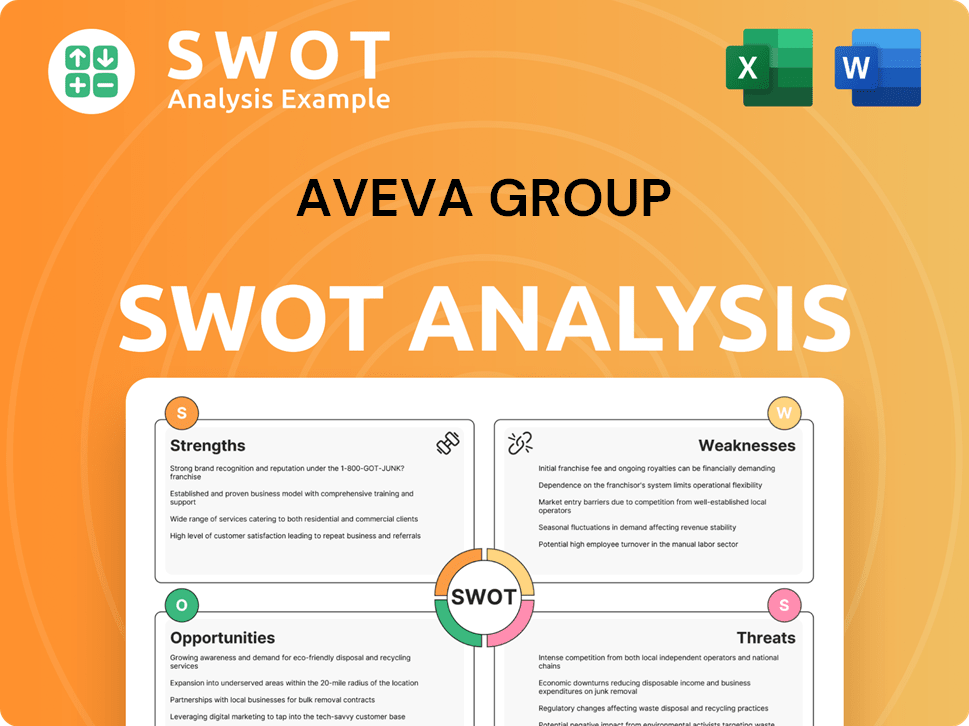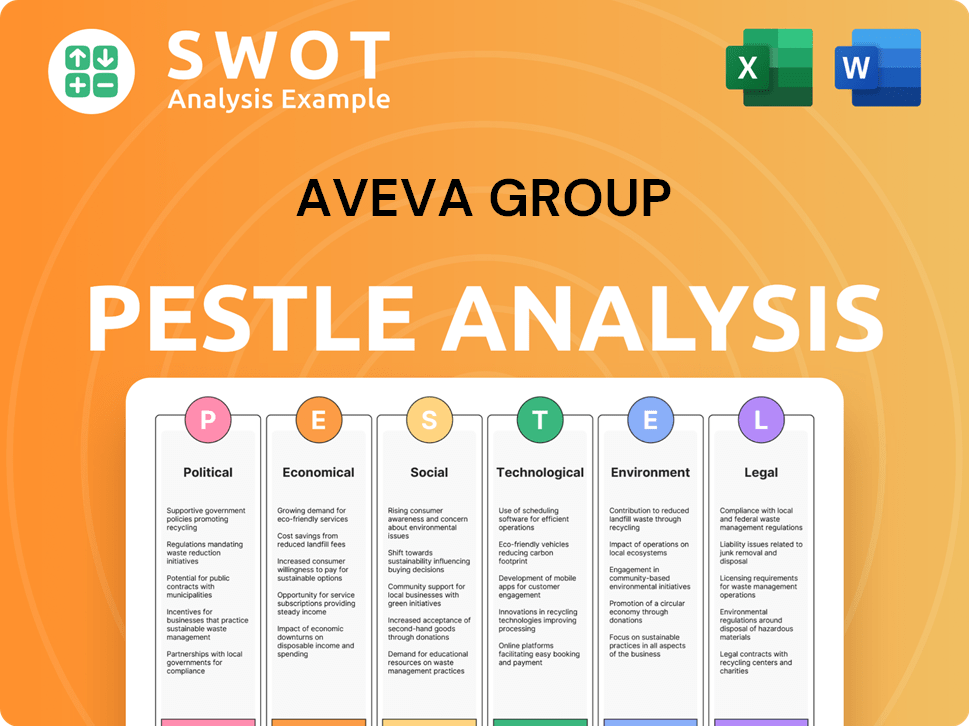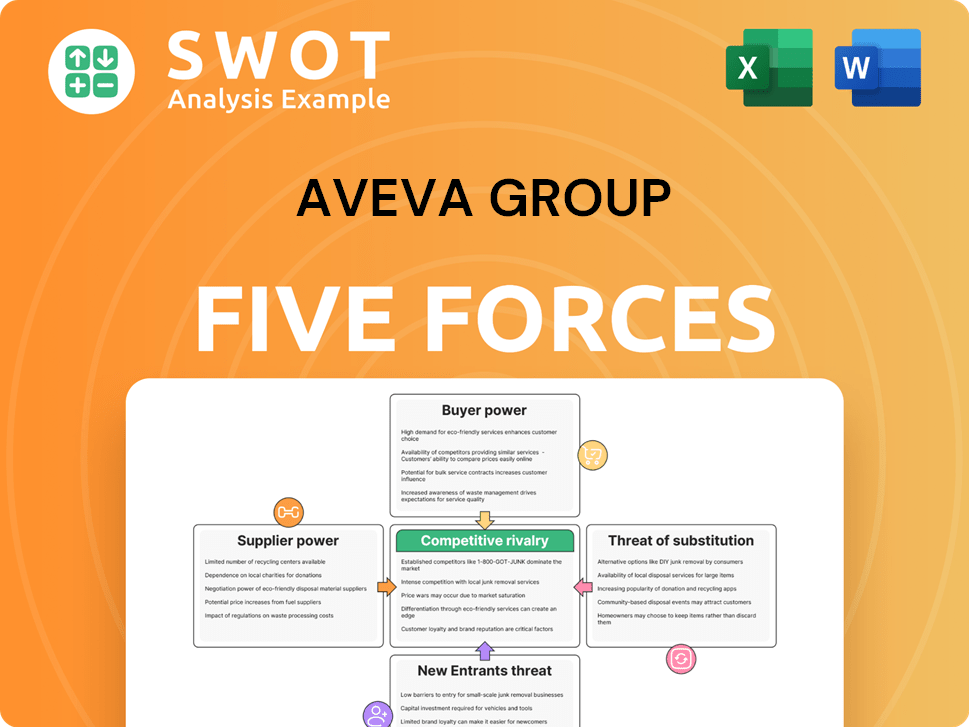AVEVA Group Bundle
How Did AVEVA Group Become an Industrial Software Giant?
From its inception in 1967, AVEVA Group's journey has been nothing short of transformative. Born from a vision to revolutionize design, the company pioneered the development of the world's first 3D Plant Design and Management System. This early innovation set the stage for AVEVA's future as a leader in AVEVA Group SWOT Analysis and industrial software solutions, impacting industries worldwide.

Explore the fascinating AVEVA history and uncover how AVEVA company navigated challenges and embraced opportunities to become a global force. This article delves into AVEVA Group's origins, key milestones, and the strategic decisions that fueled its growth in industrial software. Discover how AVEVA's commitment to engineering solutions and digital transformation has reshaped industries and continues to drive innovation.
What is the AVEVA Group Founding Story?
The story of the AVEVA Group begins in 1967, marking the genesis of a company that would become a significant player in the industrial software sector. This journey started with the establishment of the Computer-Aided Design Centre (CADCentre) in Cambridge, England. This initiative set the stage for AVEVA's future, focusing on innovation in computer-aided design and its application across various industries.
The CADCentre, a joint venture between the UK Ministry of Technology and Cambridge University, aimed to advance CAD techniques. The initial focus was on research and development, laying the groundwork for groundbreaking software solutions. This early emphasis on technological advancement and industrial efficiency shaped the company's trajectory, leading to the development of pioneering products.
The CADCentre's first director, Arthur Llewelyn, contracted ICL for staff recruitment and management. The primary goal was to promote the use of computer-aided design (CAD) within British industries. This initiative was a response to the growing need for more efficient design processes. This early focus on innovation and practical application set the stage for AVEVA's future contributions to the industrial sector.
AVEVA's origins trace back to 1967 with the establishment of the Computer-Aided Design Centre (CADCentre) in Cambridge, England.
- The CADCentre was a joint venture between the UK Ministry of Technology and Cambridge University.
- The initial focus was on research and development to create innovative CAD software.
- The first significant product was the world's first 3D Plant Design and Management System (PDMS™), launched in 1976.
- This system allowed designers to create virtual 3D models of processing plants, aiding in construction designs and clash analysis.
The CADCentre's original business model was centered on research and development, with the goal of creating innovative CAD software. A major breakthrough came in 1976 with the launch of the world's first 3D Plant Design and Management System (PDMS™). This system was a significant advancement, enabling designers to create virtual 3D models of processing plants. This innovation allowed for improved construction designs, better material requirements planning, and clash analysis, marking a pivotal moment in the company's early history. The development of PDMS™ was a direct response to the needs of the engineering industry, providing a solution for complex design challenges.
While specific details about the company name selection or initial funding sources beyond government funding are not widely detailed, the context of the company's establishment was influenced by a cultural and economic environment that emphasized technological advancement and industrial efficiency in the UK. The founding team's expertise in computer-aided design, a nascent field at the time, drove them to pursue this venture with a mission to develop and promote these techniques for British industry. This dedication to innovation and industry-specific solutions has been a consistent theme throughout AVEVA's history. For more detailed information about the company's structure, you can read more about Owners & Shareholders of AVEVA Group.
AVEVA Group SWOT Analysis
- Complete SWOT Breakdown
- Fully Customizable
- Editable in Excel & Word
- Professional Formatting
- Investor-Ready Format

What Drove the Early Growth of AVEVA Group?
The early years of the AVEVA Group, then known as CADCentre, were marked by the development and commercialization of pioneering 3D plant design software. The launch of Plant Design Management System (PDMS™) in 1976 was a significant milestone, establishing the company's reputation in industrial design. This was followed by the introduction of the world's first intelligent P&ID system (PEGS) in 1979, setting the stage for future growth in the engineering software market.
In 2001, the company rebranded from CADCentre to AVEVA, signaling a shift towards broader market opportunities. This period saw strategic acquisitions that expanded AVEVA's offerings and market reach. These moves were crucial in shaping AVEVA's trajectory, broadening its technology stack, and increasing its market presence within the industrial software sector.
AVEVA made several key acquisitions to strengthen its position. In 2004, it acquired Tribon Solutions for $35 million, adding naval architecture software. Further acquisitions included Logimatic's MARS business in 2010 for £12.8 million and ADB Systemer AS. The 2011 acquisition of LFM software from Z+F UK Limited allowed AVEVA to enter the 3D data capture market.
AVEVA's growth was further highlighted by its listing on the London Stock Exchange in 1996. The company's entry into the FTSE 250 in 2006 demonstrated its increasing prominence and successful capital raises. These milestones underscored AVEVA's evolution and its growing influence in the engineering solutions market.
Alongside acquisitions, AVEVA continued to enhance its core products, including P&IDs, electrical systems, and laser scanning technologies. These developments supported AVEVA's mission to provide comprehensive engineering solutions. The company's focus on innovation and strategic expansion has been crucial for its role in digital transformation.
AVEVA Group PESTLE Analysis
- Covers All 6 PESTLE Categories
- No Research Needed – Save Hours of Work
- Built by Experts, Trusted by Consultants
- Instant Download, Ready to Use
- 100% Editable, Fully Customizable

What are the key Milestones in AVEVA Group history?
The AVEVA Group has a rich AVEVA history, marked by significant achievements in the industrial software and engineering solutions sectors. The AVEVA company has consistently pushed boundaries, shaping how industries approach digital transformation.
| Year | Milestone |
|---|---|
| 1976 | Launched the world's first 3D Plant Design and Management System (PDMS™). |
| 1979 | Introduced the world's first intelligent P&ID system (PEGS). |
| 2008 | Announced the world's first open standards-based integration of P&ID and 3D design modeling. |
| 2016 | Launched AVEVA Engage™, a decision support system for collaborative decision-making. |
| 2018 | Merged with Schneider Electric's industrial software business, with Schneider Electric becoming the largest shareholder. |
| 2021 | Completed the acquisition of OSIsoft for £3,831.4 million (US$5 billion). |
| 2023 | Schneider Electric completed its full acquisition of AVEVA, valuing the company at approximately £9.48 billion (US$10.8 billion). |
| 2024 | Announced strategic alliances with Databricks and Track'em at AVEVA World in San Francisco. |
| 2025 | Partnered with ServiceNow to accelerate industrial transformation through their CONNECT platform. |
AVEVA has consistently been at the forefront of innovation, particularly in industrial software. The company's early adoption of laser scanning technology and the development of systems for generating and dynamically updating dashboards are key examples.
The world's first 3D Plant Design and Management System (PDMS™) was a groundbreaking innovation in 1976, revolutionizing the way plants were designed and managed. This system provided a comprehensive solution for creating and maintaining 3D models of industrial facilities, improving efficiency and accuracy.
In 1979, AVEVA introduced the world's first intelligent P&ID system (PEGS), which streamlined the creation and management of Piping and Instrumentation Diagrams. This system enhanced the accuracy and efficiency of engineering processes.
In 2008, AVEVA announced the world's first open standards-based integration of P&ID and 3D design modeling. This integration allowed for seamless data exchange between different design tools, improving collaboration and reducing errors.
Launched in 2016, AVEVA Engage™ is a decision support system designed for collaborative decision-making across capital projects and operations. It provides a centralized platform for accessing and analyzing data, improving decision-making processes.
AVEVA has consistently pioneered laser scanning technology, using it to create accurate 3D models of existing facilities. This technology is crucial for brownfield projects, enabling efficient upgrades and expansions.
Recent patents granted in 2024 and 2025 include methods for generating and dynamically updating dashboards, and server systems using vision AI for data collection. These innovations highlight AVEVA's commitment to leveraging AI for enhanced data analysis and operational efficiency.
The AVEVA company has faced challenges such as market downturns and competitive pressures. The acquisition of OSIsoft, while strategically important, led to significant amortization charges.
AVEVA has navigated through periods of economic uncertainty, which have impacted the demand for industrial software and engineering solutions. These downturns require strategic adjustments to maintain market position and profitability.
The industrial software market is highly competitive, with various companies vying for market share. AVEVA must continuously innovate and differentiate its offerings to stay ahead of competitors and maintain a strong market presence.
The acquisition of OSIsoft in 2021, while expanding AVEVA's capabilities, also brought challenges related to integrating the acquired business. This included managing the amortization of acquired assets and aligning the two companies' operations.
In 2023, AVEVA faced impacts from wage inflation due to a competitive software labor market. This increased operational costs, requiring adjustments to maintain financial performance and attract talent.
The merger with Schneider Electric's industrial software business and the subsequent full acquisition required significant strategic adjustments. These shifts involved integrating operations, aligning visions, and adapting to new ownership structures.
AVEVA has learned to adapt and strengthen its focus on digital transformation, cloud services, and AI-driven solutions. This strategic focus aligns its achievements and challenges with the broader industry trends of digitalization and sustainability.
AVEVA Group Business Model Canvas
- Complete 9-Block Business Model Canvas
- Effortlessly Communicate Your Business Strategy
- Investor-Ready BMC Format
- 100% Editable and Customizable
- Clear and Structured Layout

What is the Timeline of Key Events for AVEVA Group?
Tracing the AVEVA Group's journey reveals a rich history of innovation in industrial software and engineering solutions. From its inception as the Computer-Aided Design Centre in 1967 to its current status as a leader in digital transformation, AVEVA has consistently pushed the boundaries of what's possible in the industrial sector. The company's evolution reflects its commitment to developing cutting-edge technologies and adapting to the changing needs of its customers. The following timeline highlights key milestones in the AVEVA company history.
| Year | Key Event |
|---|---|
| 1967 | Established as the Computer-Aided Design Centre (CADCentre) in Cambridge, England. |
| 1976 | Launched the world's first 3D Plant Design and Management System (PDMS™). |
| 1979 | Launched the world's first intelligent P&ID system (PEGS). |
| 1996 | Listed on the London Stock Exchange. |
| 2001 | CADCentre officially changed its name to AVEVA. |
| 2004 | Acquired Tribon Solutions for $35 million, expanding into naval architecture software. |
| 2006 | Entered the FTSE 250 on the London Stock Exchange. |
| 2010 | Acquired Logimatic's MARS business and ADB Systemer AS. |
| 2011 | Acquired LFM (Light Form Modeller) software division. |
| 2016 | Launched AVEVA Engage™, a decision support system. |
| 2018 | Merged with Schneider Electric's industrial software business, with Schneider Electric taking a 60% ownership stake. |
| 2020 | Announced agreement to acquire OSIsoft for US$5 billion, completed in March 2021. |
| 2023 (January 18) | Schneider Electric completed the full acquisition of AVEVA. |
| 2024 (April) | Unveiled CONNECT, a state-of-the-art industrial intelligence platform at Hannover Messe, and launched a new hybrid MES solution. |
| 2025 (January) | Recognized as a Leader in the IDC MarketScape for Worldwide Manufacturing Execution Systems 2024-2025 Vendor Assessment. |
| 2025 (March) | Appointed Arti Garg as new Chief Technologist, focusing on advancing the company's strategy in Generative AI. |
| 2025 (April) | Announced strategic partnerships with Databricks and ServiceNow, further enhancing its industrial intelligence platform CONNECT and driving industrial transformation. |
AVEVA is focused on accelerating its software growth strategy. This involves transitioning to an industrial hybrid cloud-based subscription model. The CONNECT platform is central to these initiatives, serving as an integration backbone for its portfolio and the foundation for future innovation. In 2024, cloud revenue represented over 25% of total sales, indicating a strong shift toward cloud services.
The company is expanding its CONNECT platform with new capabilities for AVEVA Unified Engineering, AVEVA Operations Control, and AVEVA PI Data Infrastructure. An Industrial AI Assistant for conversational insights is also being developed. The evolution of CONNECT aims to drive efficiency, agility, and sustainability by building connected information ecosystems.
Industry trends such as the increasing demand for cloud services and the adoption of AI will significantly impact AVEVA's future. The company is investing heavily in digital tools to support supply chain digitization. Smart solutions like digital twins are being implemented to optimize resource management and cost savings.
Leadership is committed to embedding intelligence and enhancing usability across the portfolio. The focus is on unifying IT/OT data. AVEVA's ongoing strategic initiatives align with its founding vision, now reimagined for the era of industrial intelligence and digital transformation, driving the future of the AVEVA Group.
AVEVA Group Porter's Five Forces Analysis
- Covers All 5 Competitive Forces in Detail
- Structured for Consultants, Students, and Founders
- 100% Editable in Microsoft Word & Excel
- Instant Digital Download – Use Immediately
- Compatible with Mac & PC – Fully Unlocked

Related Blogs
- What is Competitive Landscape of AVEVA Group Company?
- What is Growth Strategy and Future Prospects of AVEVA Group Company?
- How Does AVEVA Group Company Work?
- What is Sales and Marketing Strategy of AVEVA Group Company?
- What is Brief History of AVEVA Group Company?
- Who Owns AVEVA Group Company?
- What is Customer Demographics and Target Market of AVEVA Group Company?
Disclaimer
All information, articles, and product details provided on this website are for general informational and educational purposes only. We do not claim any ownership over, nor do we intend to infringe upon, any trademarks, copyrights, logos, brand names, or other intellectual property mentioned or depicted on this site. Such intellectual property remains the property of its respective owners, and any references here are made solely for identification or informational purposes, without implying any affiliation, endorsement, or partnership.
We make no representations or warranties, express or implied, regarding the accuracy, completeness, or suitability of any content or products presented. Nothing on this website should be construed as legal, tax, investment, financial, medical, or other professional advice. In addition, no part of this site—including articles or product references—constitutes a solicitation, recommendation, endorsement, advertisement, or offer to buy or sell any securities, franchises, or other financial instruments, particularly in jurisdictions where such activity would be unlawful.
All content is of a general nature and may not address the specific circumstances of any individual or entity. It is not a substitute for professional advice or services. Any actions you take based on the information provided here are strictly at your own risk. You accept full responsibility for any decisions or outcomes arising from your use of this website and agree to release us from any liability in connection with your use of, or reliance upon, the content or products found herein.